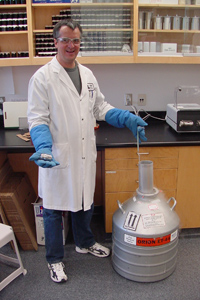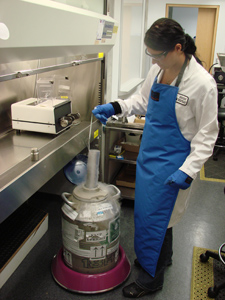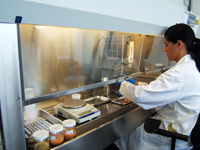Laboratories and research support: National Wildlife Specimen Bank
| Article Title |
|---|
National Wildlife Specimen Bank |
The National Wildlife Specimen Bank houses over 900,000 biological sub-samples taken from 200,000 tissue samples of over 800 species.

Scientists use these samples to conduct research on contaminants monitoring and the effects of toxic chemicals on the environment. This research helps develop science-based regulations controlling the use, distribution, application, and disposal of chemicals.
Started in 1963 as the Canadian Wildlife Service Specimen Bank, the National Wildlife Specimen Bank gives scientists the unique ability to use historical environmental specimens to:
- screen for new chemical contaminants
- retrospectively analyze emerging contaminants of concern
- conduct analysis in the future using more sophisticated analytical equipment
- investigate environmental trends

Recent uses of the specimen bank go beyond the initial intentional use. Samples are now also used to build knowledge in new fields of research including:
- stable isotope analysis to better understand species' diet patterns and migration. This information helps identify critical habitat to wildlife and can set land conservation priorities
- DNA analysis to catalogue species and examine genetic drift
- pathogen and disease investigation
- scientific analysis to support Canada's Chemicals Management Plan
Specimen Collection
Field scientists submit about 3000 samples annually. These are processed for long-term storage or prepared for real-time analysis by the Tissue Preparation and Specimen Bank Unit of Laboratory Services.
Ninety-six per cent of the archive samples are collected from within Canada: 33% from Ontario, 17% from Quebec, 13% from British Columbia, 13% from the NWT/Nunavut, and 20% from the other provinces and the Yukon. The remainder, close to 5%, is from the USA, South America, northern Europe and Mexico.

This table describes the taxonomic groups represented in the Specimen Bank, and identifies what percentage of the total bank the taxonomic group is.
| Taxonomic Group | Percentage of Bank |
|---|---|
| Bird | 77 |
| Mammal | 9 |
| Environmental | 4 |
| Fish | 4 |
| Reptile | 3 |
| Amphibian | 2 |
| Invertebrate | 1 |
Storage Conditions
Tissue samples are stored in three walk-in freezers at -40°C, totalling 270 cubic metres. Samples intended for use in biochemical studies are deep-frozen in three liquid nitrogen freezers with vapour phase below -130°C, and seven chest freezers at -80°C. Each freezer is constantly monitored for ideal temperature and protected from electrical failure to maintain sample integrity.
Information Management
A customized LIMS LabVantage system has been created to process information about the specimen bank. This secure MS Access relational database captures details about the field data, tissue processing and tissue archiving.

Analytical data are maintained and backed up by each laboratory unit and are easily retrievable by authorized personnel. Paper files containing information on field collections, processing, analyses and any correspondence are also kept.
Access to Specimens

Experts in Laboratory
- Guy Savard
- Lisa Hermsen
- Christine McClelland
Further Reading
- Braune, B.M., G. Savard, B.J. Wakeford and D.J. McGoldrick. 2010. Environment Canada's National Wildlife Specimen Bank: A valuable resource for monitoring and research. In Interdisciplinary Studies on Environmental Chemistry - Environmental Specimen Bank. Eds. T.Isobe, K. Nomiyama, A. Subramanian and S. Tanabe. 25-32.
- Banking for the future, Environment Canada
- Environment Canada's National Environmental Specimen Banks: Following a chemical trail from the past, Environment Canada
- The National Aquatic Biological Specimen Bank and Database, Environment Canada
- International Environmental Specimen Bank Group (ISEB)
- Wakeford, B. and R. Turle. 1996. "In-house reference materials as a means to quality assurance: The Canadian Wildlife Service experience." In R.E. Clement, L.H. Keith, and K.W. Michael Siu (eds.) Reference Materials for Environmental Analysis. CRC Lewis, Boca Raton, Florida
- A Guide to the Canadian Wildlife Service National Registry of Toxic Chemical Residues. 1987. CWS Technical Report Series 27.
- Wakeford, B.J. and M.T. Kasserra. 1997. The relationship between the Canadian Wildlife Service Specimen Bank and the Wildlife Toxicology Program: The effect on specimen collection. Chemosphere 34: 1933-1938.
- Hebert, C.E., R.J. Norstrom, and D.V.C. Weseloh. 1999. A quarter century of environmental surveillance: The Canadian Wildlife Service’s Great Lakes Herring Gull Monitoring Program. Environmental Reviews 7: 147-166.